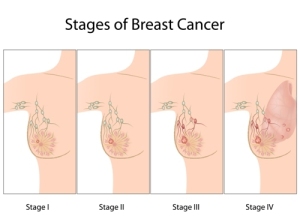Speakers from various cancer centers around the world and the cancer literature support the notion that an accurate and appropriate staging of any cancer is absolutely essential to get the best cancer treatment.
For instance, it took a few decades to appreciate with breast cancer that even a small lesion of 1. 5 cm (just a bit more than ½ inch) has a high probability of having metastases already.
Breast cancer metastasizes early
Beyond 1 cm the tissue pressure in the primary tumor (breast cancer) is such that the cancer cells are being shed into the lymphatic system, where the lymph glands filter the cancer cells.
Before long this leads to further spread via the blood stream into the bone marrow, where micro bone metastases form and wait for the next growth spurt. For reasons, which physicians do not entirely understand yet such micro metastases can linger on without detection for possibly several years. This likely is the reason why some breast cancers that are detected early and appeared to be cured by a simple lumpectomy or by mastectomy sometimes develop late metastases.
Breast cancer staging and micrometastases
Breast cancer staging allows the physician to treat the cancer according to how far it has spread. The breast cancer chapter elsewhere explains that chemotherapy is often given to eradicate micro metastases following a lumpectomy. Tamoxifen also is given for that reason. However, with the experience of the use of bio-identical progesterone by anti-aging medicine physicians it is now clear that this is a much safer treatment of residual micro metastases than Tamoxifen (Ref. 16).
It is important to employ the latest technology to be certain about the cancer stage before engaging in treatment. Sometimes patients get irritated that they have to undergo more tests when they already have histological proof of the type of cancer.
Further tests to determine the extent of the spread of breast cancer
However, these further tests are vital for long term survival, as the physician must know exactly how far the cancer has spread as various anticancer drugs may have to be combined and the exact combination might be given in a different sequence for a different stage. Some of the rational for this is explained in the various cancer chapters in more detail. Ask your doctor or oncologist (who is the specialist for cancer) why certain tests have to be done so that you understand the reasons.
References
1. JK McLaughlin et al. Int J Cancer 1995 Jan 17; 60(2): 190-193.
2. GN Wogan Semin Cancer Biol 2000 Jun 10(3): 201-210.
3. L Garfinkel et al. Stat Bull Metrop Insur Co 1999 Jul-Sep;80(3): 23-32.
4. G Torres-Mejiha et al. Int J Cancer 2000 Sep 15;87(6): 869-873.
5. M Feuring-Buske et al. Ann Hematol 2000 Apr 79(4): 167-174.
6. RJ Kreitman et al. J Clin Oncol 2000 APR 18(8): 1622-36.
7. SA Rosenberg et al. Ann Surg 1998 Sep 228(3): 307-319.
8. K Fujita et al. Clin. Cancer Res 1995 May 1(5): 501-507.
Further references
9. J van der Zee et al. Lancet 2000 Apr1; 355(9210): 1119-1125.
10. H Ge and J Huang J Surg Oncol 2000 Jul 74(3): 193-195.
11. P Hillemanns et al. Int J Cancer 2000 March 1; 85(5): 649-653.
12. K Moghissi et al. Eur J Cardiothorac Surg 1999 Jan 15(1): 1-6.
13. Cancer: Principles &Practice of Oncology.4th edition. Edited by Vincent T. DeVita, Jr. et al. Lippincott, Philadelphia,PA, 1993. Chapter 70:”Unsound methods of cancer treatment”, page 2734 -2747.
14. Cancer: Principles&Practice of Oncology. 5th edition, volume 1. Edited by Vincent T. DeVita, Jr. et al. Lippincott-Raven Publ., Philadelphia,PA, 1997. The data from the tables on p. 236-237 were condensed and the figures rounded off to the nearest full number.
15. C Dong et al. Int J Cancer 2001 Apr 1;92(1):144-150.
16. Dr. John R. Lee, David Zava and Virginia Hopkins: “What your doctor may not tell you about breast cancer – How hormone balance can help save your life”, Wellness Central, Hachette Book Group USA, 2005. Page 29 – 38 (Chapter 2): Risk factors for breast cancer. Page 360 to 374 explains about xenohormones and how they cause estrogen dominance. Pages 221 to 234 (chapter 12) explains why anti-ging physicians do not recommend tamoxi and bio-identical progesterone is more powerful in preventing breast and uterine cancer.







